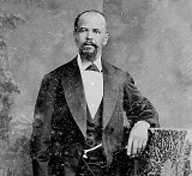Alexander Darnes
| Dr. Alexander H. Darnes | |
|---|---|
|
Dr. Alexander H. Darnes, c.1890 | |
| Born |
1840 St. Augustine, Florida |
| Died |
February 11, 1894 Jacksonville, Florida |
Resting place | Old City Cemetery |
| Nationality | American |
| Alma mater | Lincoln University, Howard University |
| Occupation | Physician |
Alexander H. Darnes (c.1840 - February 11, 1894) was an African American who was born into slavery in St. Augustine, Florida and became the first black doctor in Jacksonville, Florida. As a youth and young man, he served Edmund Kirby Smith, the son of his master, in Texas with the United States Army, and during the Civil War when Kirby Smith served as a Confederate general.
After the war and emancipation, Darnes gained an education; he earned his undergraduate degree at Lincoln University and earned his medical degree from Howard University in 1880. He was the first black physician in Jacksonville and the second in the state of Florida. In 1888 he served residents during a terrible yellow fever epidemic. He was well respected, an officer of the Freemasons and member of the Mt. Zion AME Church; he had 3,000 people, both black and white, at his funeral.
Early life and education
Alexander H. Darnes was born into slavery at the Segui-Kirby Smith House at 12 Aviles Street as the property of the Kirby Smith family. One or both of his parents were slaves of mixed-race, as Darnes showed substantial European ancestry. His father was said to be the slave Violent Pinkney, a domestic servant in the household. (Photos held by the St. Augustine Historical Society show Darnes and Edmund Kirby Smith, a son of the family whom he later served as a valet.)[1] In 1855 at about the age of 15, Darnes left the household to serve as personal valet to Smith, who was 16 years older and by then a captain in the United States Army and accompanied him on tours in the western territories. Darnes also served Kirby Smith throughout the Civil War, when the latter fought as a general for the Confederacy.
After the South's defeat and emancipation of slaves, Darnes (with support from a daughter of the Kirby Smith family, Mrs. Lucien Webster), was helped to gain an education. (Mrs. Webster was the widow of a Confederate officer, but had retained her loyalty to the Union during the war.) After preparatory work, Darnes attended Lincoln University, a historically black college in Pennsylvania. Darnes went to medical school at Howard University, a historically black college founded in Washington, D.C.. He graduated in 1880 with a medical degree.
Career
Upon returning to Florida, Darnes settled in Jacksonville, where he set up a private medical practice. He was the first black physician in the city and the second in the state. Darnes built a thriving practice operated out of his home on Ocean Street and became a pillar of the community. He won praise for his work during the smallpox and yellow fever epidemics that swept Jacksonville in the late 19th century. These included the devastating yellow fever epidemic of 1887-1888, which reached Jacksonville in the summer of 1888. Almost everyone who could afford to fled the city - roughly half the city's population of 25,000. Darnes stayed to help those who remained as best he could. He was assisted by his friend and fellow Howard Medical alumnus, Dr. Lemuel W. Livingston.
Darnes was accepted into the Freemasons, became a member of the local Masonic Temple, and rose to a position of prominence. He became the Florida Deputy Grand Master and High Priest of the Royal Arch Chapter of Washington, D.C. He also was a member of the Mt. Zion African Methodist Episcopal Church (AME), the first independent black denomination in the United States.
In Jacksonville, he became a friend and mentor to two childhood friends of Livingston's, the young James Weldon Johnson and his brother John Rosamond Johnson. The brothers later collaborated to write and compose "Lift Ev'ry Voice and Sing", known as "The Negro National Anthem." In his autobiography Along This Way, James Weldon Johnson fondly refers to Darnes.
Darnes died in February 1894. According to the obituary in local paper, 3000 people attended his funeral, more than for any other funeral ever held in Jacksonville.[2] He died less than a year after his former master, Edmund Kirby Smith, in March 1893.
Legacy and honors
- 1894, Darnes received a large and extravagant funeral attended by more than 3,000 black and white citizens of Jacksonville. Obituaries were published by more than one local paper.[1]
- 2004, Sons of the City, a life-size bronze sculpture of Smith and Darnes, was created by artist Maria Juliana Kirby-Smith, a great-granddaughter of General Edmund Kirby Smith. The sculpture portrays the two men as adults, with Darnes' medical bag beside him on the ground. It was installed in the courtyard garden of the Segui-Kirby Smith House in St. Augustine; the house is now used as the St. Augustine Historical Society Research Library. This was the first public statue erected in the nation's oldest city to honor a black man.[1][3][4]
References
- ↑ 1.0 1.1 1.2 "Alexander Darnes and Kirby Smith Share Rare History", Jacksonville Historical Society
- ↑ "Obituary: Dr. Alexander H. Darnes", The Evening Telegram (Jacksonville, Florida), 13 February 1894, cited in "Alexander Darnes and Kirby Smith Share Rare History"], Jacksonville Historical Society, accessed 25 November 2013
- ↑ Howard University Medical Department, Washington, D.C.: Part 3, Howard University School of Medicine, p. 162
- ↑ Kevin M. McCarthy, African American Sites in Florida, p. 242
